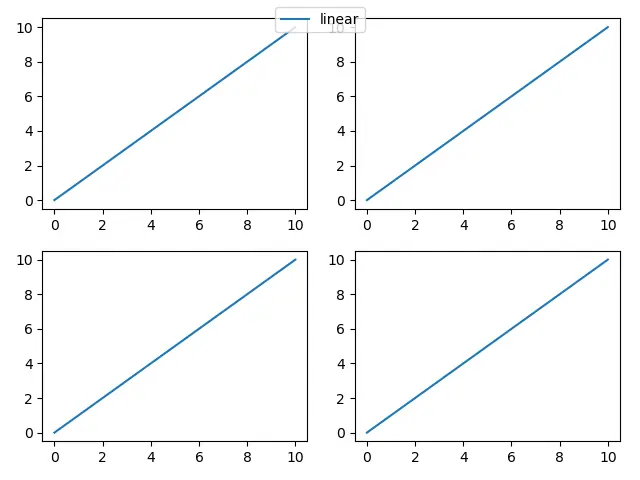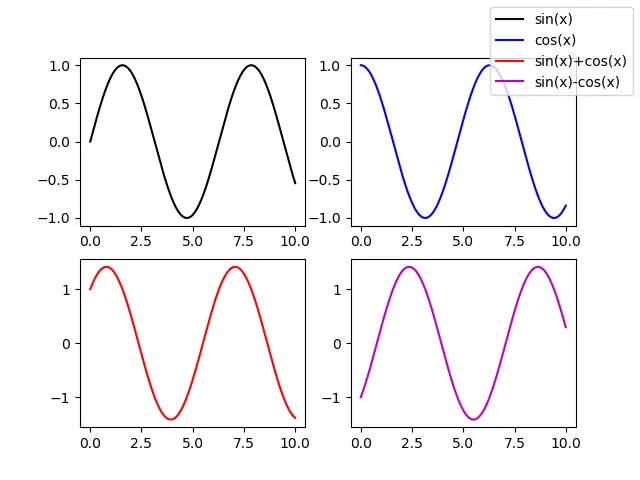Matplotlib のすべてのサブプロットに単一の凡例を作成する方法
胡金庫
2023年1月30日
Matplotlib
Matplotlib Legend
-
Matplotlib の
figure.legendメソッドですべてのサブプロットの単一の凡例を作成する -
Matplotlib でラインハンドルとラインが異なる場合、
figure.legendメソッドを使用してすべてのサブプロットの単一の凡例を作成する

Matplotlib figure クラスには、legend メソッドを figure レベルに配置するが、subplot レベルには配置しない legend メソッドがあります。ラインのパターンとラベルがすべてのサブプロットで同じである場合に特に便利です。
Matplotlib の figure.legend メソッドですべてのサブプロットの単一の凡例を作成する
import matplotlib.pyplot as plt
fig = plt.figure()
axes = fig.subplots(nrows=2, ncols=2)
for ax in fig.axes:
ax.plot([0, 10], [0, 10], label="linear")
lines, labels = fig.axes[-1].get_legend_handles_labels()
fig.legend(lines, labels, loc="upper center")
plt.show()

lines, labels = fig.axes[-1].get_legend_handles_labels()
すべてのサブプロットが同じラインとラベルを持っていると仮定しているため、最後の Axes のハンドルとラベルを Figure 全体に使用できます。
Matplotlib でラインハンドルとラインが異なる場合、figure.legend メソッドを使用してすべてのサブプロットの単一の凡例を作成する
ラインパターンとラベルがサブプロット間で異なるが、すべてのサブプロットに 1つの凡例が必要な場合、すべてのサブプロットからすべてのラインハンドルとラベルを取得する必要があります。
import matplotlib.pyplot as plt
import numpy as np
x = np.linspace(0, 10, 501)
fig = plt.figure()
axes = fig.subplots(nrows=2, ncols=2)
axes[0, 0].plot(x, np.sin(x), color="k", label="sin(x)")
axes[0, 1].plot(x, np.cos(x), color="b", label="cos(x)")
axes[1, 0].plot(x, np.sin(x) + np.cos(x), color="r", label="sin(x)+cos(x)")
axes[1, 1].plot(x, np.sin(x) - np.cos(x), color="m", label="sin(x)-cos(x)")
lines = []
labels = []
for ax in fig.axes:
axLine, axLabel = ax.get_legend_handles_labels()
lines.extend(axLine)
labels.extend(axLabel)
fig.legend(lines, labels, loc="upper right")
plt.show()

for ax in fig.axes:
axLine, axLabel = ax.get_legend_handles_labels()
lines.extend(axLine)
labels.extend(axLabel)
単一の 1つのサブプロットにさらにラインとラベルが存在する場合に備えて、すべてのラインハンドルとラベルがリスト extend メソッドを使用して lines および labels リストに追加されます。
チュートリアルを楽しんでいますか? <a href="https://www.youtube.com/@delftstack/?sub_confirmation=1" style="color: #a94442; font-weight: bold; text-decoration: underline;">DelftStackをチャンネル登録</a> して、高品質な動画ガイドをさらに制作するためのサポートをお願いします。 Subscribe
著者: 胡金庫
